Astilba Younique Carmine
Astilba is a hybrid variety, Unique Carmine, bred in Holland. The compactness and decorativeness of a bush no more than 50 cm high allows it to be used for planting in a group - 4-5 species of one variety. Even more interesting will look like a carmine flower planted in the vicinity of other plants. Younique carmine astilba seedlings can be planted in any month of spring and summer.
Important! Young seedlings should be watered regularly and planted in a shaded area in a breathable, fertilized soil. The flowering of carmine astilba lasts two months.
The inflorescences cover the bush with such a dense carpet that the effect of an airy bright red, pink, purple or white cloud is created, depending on the type of flower. Green leaves with jagged edges wrap densely around the stems. The roots of the plant grow in a special way, growing not into the depths, but up the ground. Therefore, by winter they need to be well sprinkled with earth and insulated. Rhizomes can be separated and planted in 4-5 years in early spring. The distance between astilbe plants should be at least 35 cm.Decorative and small growth allow you to grow a miniature flower in pots on the window
Carmine astilba bloom lasts two months. The inflorescences cover the bush with such a dense carpet that the effect of an airy bright red, pink, purple or white cloud is created, depending on the type of flower. Green leaves with jagged edges wrap densely around the stems. The roots of the plant grow in a special way, growing not into the depths, but up the ground. Therefore, by winter they need to be well sprinkled with earth and insulated. Rhizomes can be separated and planted in 4-5 years in early spring. The distance between astilbe plants should be at least 35 cm. Decorativeness and small growth allow you to grow a miniature flower in pots on the window.

"Carmine cloud" of Astilba Younique Carmine
Popular varieties
This perennial is different in size. Gardeners are offered dwarf, undersized, medium-sized varieties with a height of 30, 60, 90 centimeters, respectively, as well as tall ones, which can reach one and a half meters. Flowering times may also vary. Lush flowers can appear on the bushes at the very beginning of June and end flowering only towards the end of the season. There are only about 200 varieties of astilba. It should be noted that they belong to 10 varieties. Pink astilbe looks gentle and at the same time spectacular; it often attracts with its appearance. Consider its most popular varieties.
"Unique Silver Pink" represents bushes up to 35-45 centimeters high. The flowers are pale pink, open in June and wither in July. They have a very pleasant delicate aroma.

Variety "Vigins" reaches a height of 25-30 centimeters. It is great for planting in dry and sunny areas. The color of the buds is lilac-pink, and the foliage is deep green. Have a late flowering period.
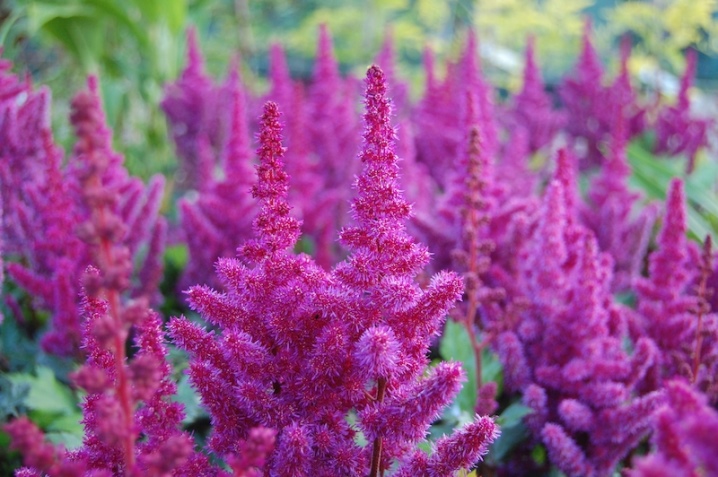
Hybrid astilba "Gloria Purpurea" is a medium-sized bushes up to 60 centimeters and is very much praised by summer residents for its attractive appearance and unpretentious care. The flowering period is June and July. The inflorescences have a raspberry-pink hue, and the leaves are cast in bronze.
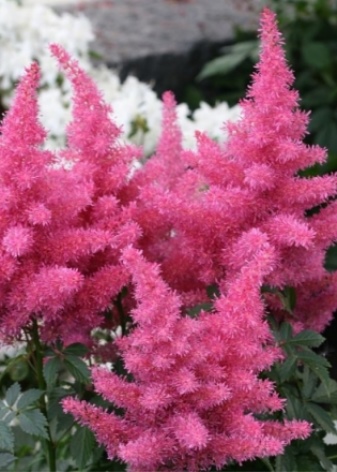
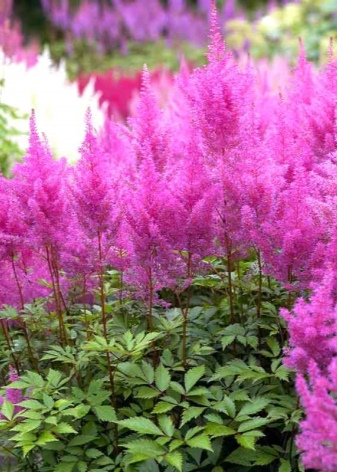
A low, but no less popular variety of pink astilba - "Perkeo". It reaches only 20 centimeters, has curly foliage and small, bright pink inflorescences. The leaves acquire a bronze tint in the spring.
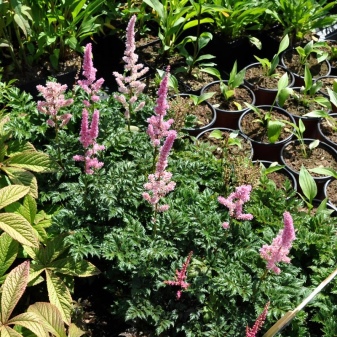
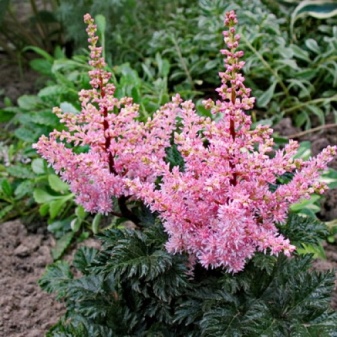
Variety "Pink Lighting" refers to undersized. The fluffy bushes are dotted with salmon pink flowers that bloom in June.
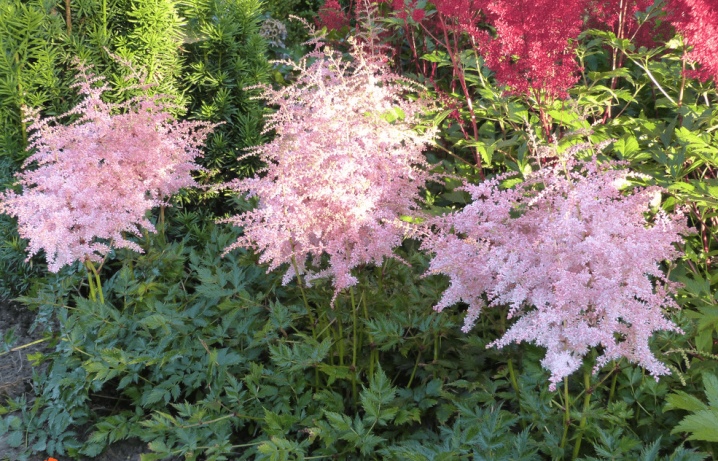
Peach Blossom has a very lush bloom starting in July.The flowers have a coral pink hue, while they are quite large, despite the fact that the height of the bush is only about 60 centimeters. The leaves are bright green.
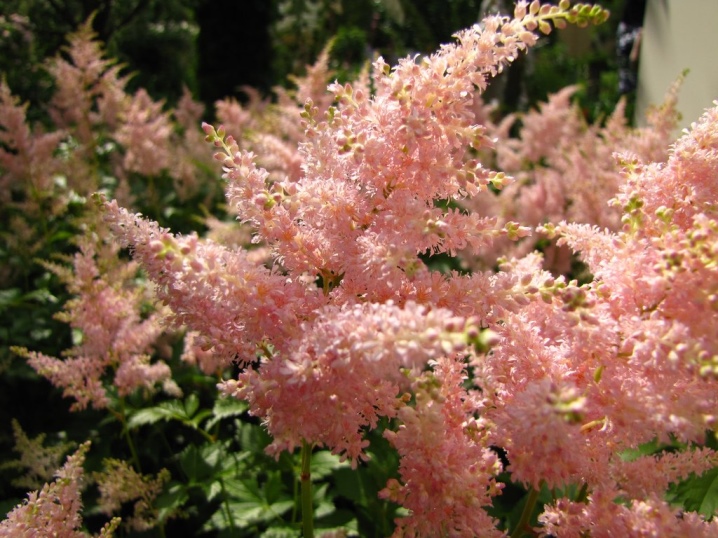
Early astilba "Rhythm and Blues" is also appreciated by gardeners. Small bushes are adorned with pyramidal panicles, which are strewn with spectacular crimson-pink flowers. The plant reaches 45 centimeters in height.
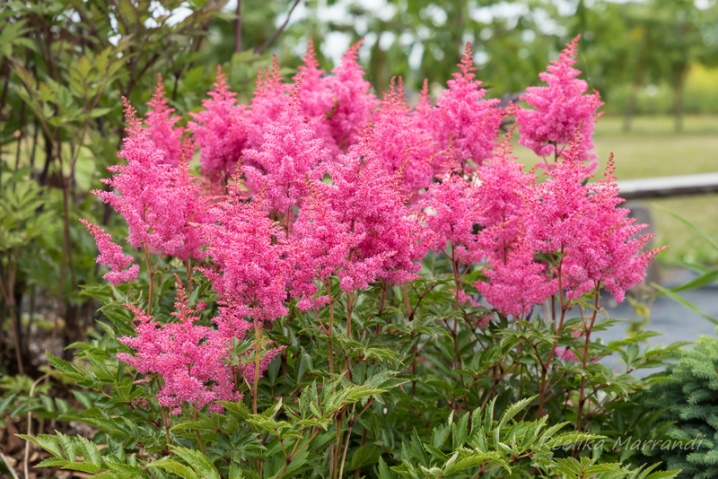
Connoisseurs of tall perennials often opt for the Strauss Feder variety. It is capable of reaching 90 centimeters in height. Astilba blooms from July to August, the buds are pink-coral, visually reminiscent of ostrich feathers, which is reflected in the name.
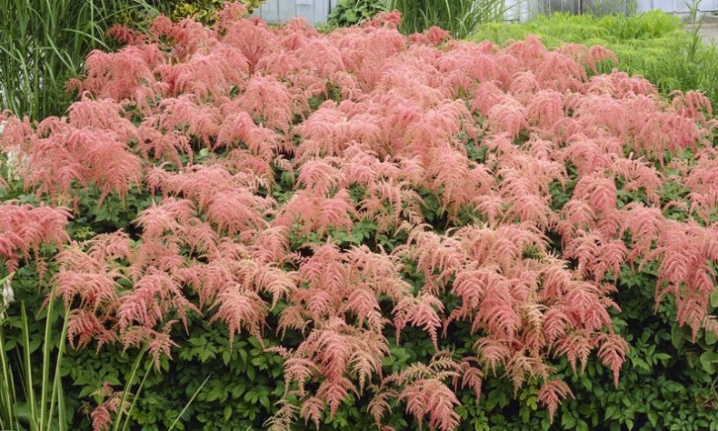
Varieties in the form of flowering
Astilba has panicle inflorescences composed of small flowers with long or small petals. Inflorescences are elongated, short, densely filled, openwork. According to the shape of the inflorescences, all astilbe can be divided into 4 groups.
- Pyramidal shape - lateral petioles of inflorescences grow from a flower stem at a right angle. The higher these branches are, the shorter they are. The whole inflorescence looks like a pyramid.
- Rhombic shape - outwardly looks like the previous one, but the lateral petioles are located at an acute angle and the entire inflorescence looks like a rhombus.
- Paniculate form - there are a lot of lateral inflorescences, they are located at an acute angle and decrease towards the crown.
- Drooping form - as the name implies, the inflorescence twigs hang down.
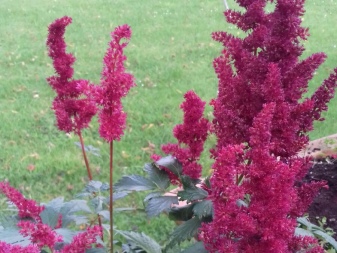

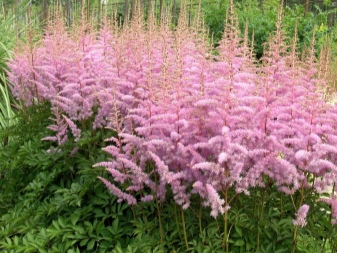

How to plant?
Before you start planting a crop, it is worth choosing the most suitable site for it. This flower does not like the sun, ultraviolet light has a detrimental effect on it, and therefore the place for planting should be in partial shade. This is a moisture-loving plant, but it will not tolerate excess moisture, which means that you should avoid areas with a close occurrence of groundwater.
Refuse planting in low-lying flower beds, where stagnant melt or rainwater is not excluded.
Another important point when planting is the choice of planting material. Visually examine the root system of the seedling, and if you notice dried or rotted fragments that exude an unpleasant odor, do not take this specimen. Purchase seedlings only from proven nurseries, and during storage, slightly moisten the roots so that they do not dry out. The planting process itself is as follows:
- dig a planting hole of such a size that the rootstock of the seedling fits easily into the dug space without much deepening;
- add mineral fertilizers, ash and hydrogel to retain moisture;
- moisten the planting site;
- place a seedling in the prepared hole so as not to fill the growth point;
- tamp the area, and water again abundantly;
- mulch the planting with bark or peat chips to retain moisture and prevent the roots from drying out.
Diseases and pests
Astilba easily ignores all diseases, she is not afraid of attacks from various parasites, but she also has ill-wishers. This plant is still visited by slobbering pennies, as well as rootworm and strawberry nematodes, but in rare cases.
- A slobbering penny is an insect that harms the plant with its suction method, its larvae will also harm the bush, they populate the leaf axils. However, it is very easy to detect them by white lumps of foam, this is the so-called secreted secret of the larvae, and they build their house out of it. For them, the sap of the plant is a valuable find, feeding on it, the larvae "suck blood" from the flower. Such pests must be immediately collected, while this is done manually, but you can use insecticides, for example: Aktaru, Confidor or Vermitic.
- The strawberry nematode is an insect that eats leaves, gnawing them like a worm gnaws an apple. As a result of this harmful process, the leaves turn yellow, and then completely brown. The appearance of these pests is easy to determine by the leaves that have been attacked by these insects. The best defense option would be to burn the bush.
- Gall nematodes feed on the root of the plant.Such a bush should be immediately uprooted and destroyed; a new specimen is not planted in this place. Keep an eye on this small flower and it will delight you with a blooming garden for many years.
Plant varieties
Given the height of the bush during the flowering period, gardeners divide astilba into dwarf (up to 30 centimeters), undersized (60 centimeters), medium-sized (90 centimeters) and tall (over 90 centimeters) varieties.
The undersized species include:
- Flowers 45 centimeters high, having a bright crimson inflorescence color. The bush grows compact and looks beautiful. Younique Carmine blooms at the beginning of summer;
- There are also Raspberry flowers with diamond-shaped inflorescences of a raspberry-purple hue. The leaves are blue-green with a silvery coating. A 25-centimeter plant blooms also in early summer;
- In June, the Younique White bush 40 centimeters high with white inflorescences begins to bloom;
- Red Sentinel shrub 60 centimeters high blooms with dark red rhombic flowers in July;
- On the Chocolate Shogun bush, 45 centimeters high, pink flowers with chocolate-purple leaves. Blooms in mid-summer;
- In the middle of summer, the Aphrodite bush blooms with lush crimson-pink flowers with bronze-red foliage.
In addition to low-growing varieties of astilbe, there is also a medium layer. These varieties include the following plants:
- In July, a bush 80 centimeters high blooms. It has white inflorescences and light green foliage with brown edges;
- From the middle of summer, the Dusseldorf variety begins to bloom with pink-red dense inflorescences. Its height is 60 - 80 centimeters;
- In July, the 80-centimeter Anita Pfeifer variety blooms with fluffy pink inflorescences;
- Mars shrubs bloom in June with dark purple inflorescences with green-red leaves;
- A bush of the Color Flash Lime variety blooms with white-pink inflorescences. In the process of growth, the foliage of the plant changes. It can be yellowish-green, brown-purple, green, dark green. A 70-centimeter plant blooms in the middle of summer. Colorful colors appear better in sunny areas;
- In July, the Bonn astilba variety blooms with fluffy pink flowers. Its height reaches only 60 centimeters;
- From the middle of summer, you can see the flowering shrubs of the Happy Spirit variety. Their height is 70 centimeters. They have dense white inflorescences with dark red peduncles.
In addition to the above varieties, there are many more varieties of astilba. To choose a plant suitable for your garden, be sure to consult with a florist who understands his business.
Types of astilba
According to botanists, there are over 350 varieties of astilba, and their number is constantly growing. However, only about 10 varieties are most often used.
Astilba nude
Low bush of small diameter, 12x15 cm. Pink flowers bloom in June-July. The leaves are cast bronze.
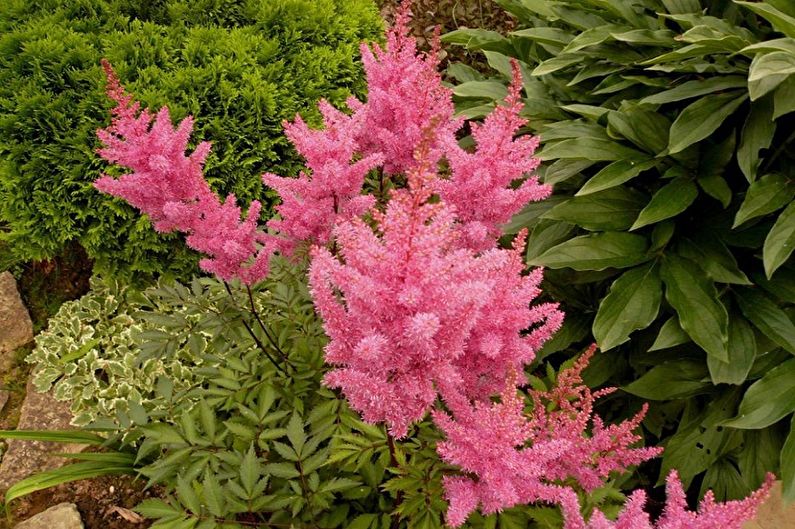
Astilba common
It differs from most types of astilba in undivided leaves of a simple configuration. The plate is green and shiny, with a rough edge. White flowers are densely gathered in pyramidal drooping inflorescences. Other colors are less common. The flowering period is July-August.

Chinese astilba
Perennial fruitful plant with complex openwork leaves of several feathers. Height - up to 100 cm. The leaf plate is shiny, with veins, covered with red hairs along the edges. The largest are basal leaves on long petioles, stem leaves are smaller and shorter. Small lilac, pink or white flowers bloom in long dense inflorescences about 30 cm long. The flowering period is late June - early August. Chinese astilbe has been known since 1859. There are several subspecies.
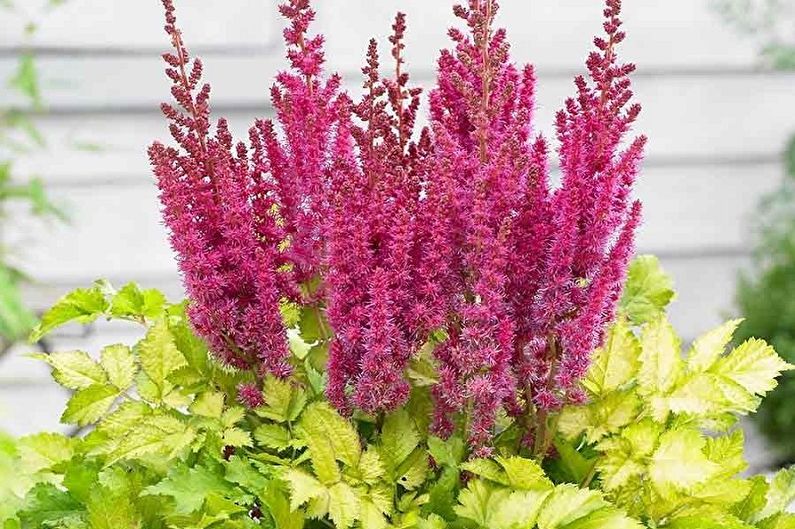
Korean astilba
It has been known since 1904 and comes from Korea and Northeast China. This is a relatively low herb up to 60 cm. Light-colored wrinkled leaves with brown hairs. Inflorescences are relatively short, up to 25 cm, but firm and dense, slightly drooping.Flowers - creamy white. The flowering period is July.

Japanese astilba
One of the first representatives of the Japanese hybrid family, known since 1837. Herbaceous perennial plant in the form of a wide spreading bush. Height - up to 80 cm. Dark feathery leaves with a glossy plate grow on reddish petioles. Small pink or white flowers gather in dense rhombic inflorescences up to 30 cm. The flowering period is July.
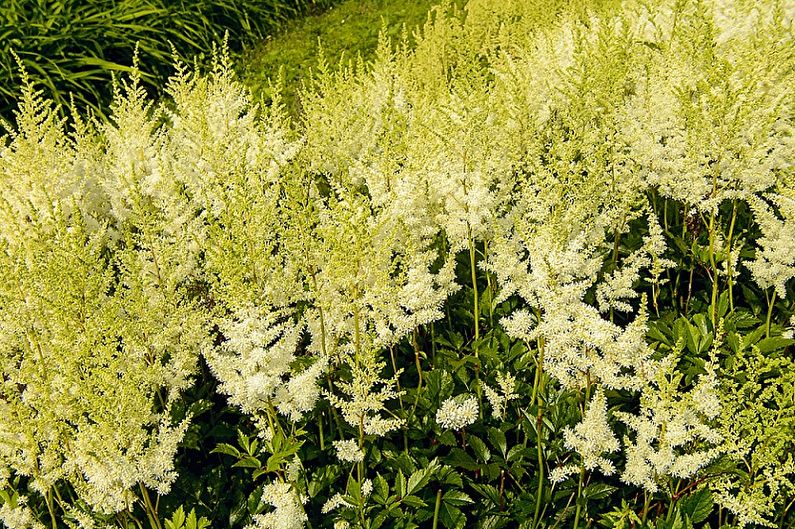
Astilba David
She has been known since 1902, and her homeland is Mongolia and North China. It is a tall, fruitful perennial plant up to 150 cm. The leaves are light, with brownish veins, compound, pinnate and wrinkled. Lilac and pink flowers bloom in narrow pyramidal inflorescences up to 40 cm long. The flowering period is July-August.
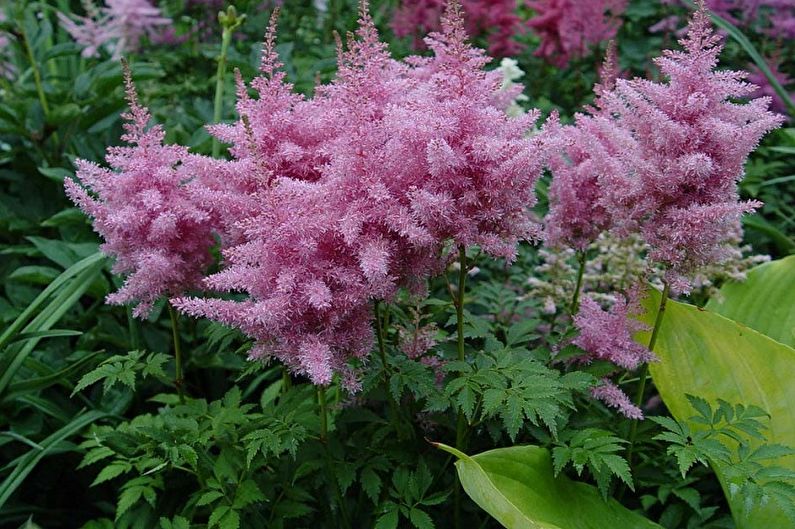
Astilba Thunberg
A specific subspecies common in the East Asian regions of Russia and Japan. Germinates in deciduous and mixed leaves. This variety has been known since 1878. The height of the bush reaches 80 cm. The peculiarity is a brown woody rhizome. Oval leaves are compound and pinnate, oval in shape with jagged edges. White flowers gather in racemose branched inflorescences of the apical type 25x10 cm. The flowering period is July-August. There are several subspecies of this variety.
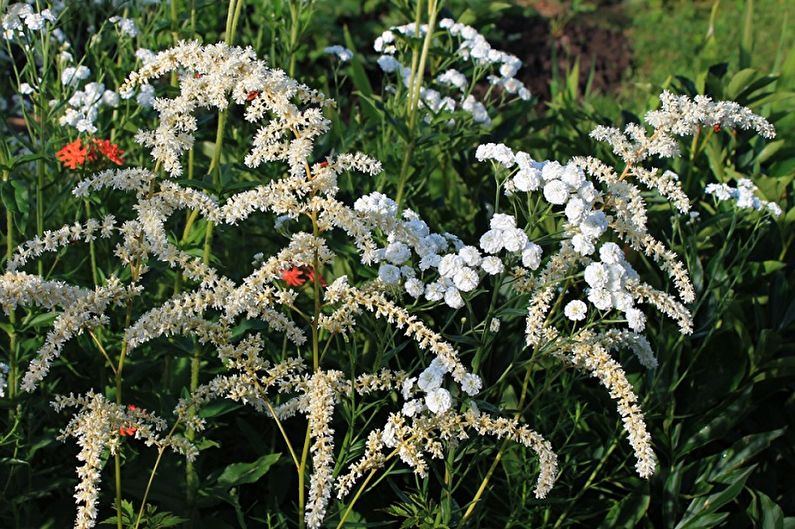
What other varieties is there a plant?

To grow astilba, it is important to buy varieties that are 50 - 70 centimeters high. They tolerate wintering and all unfavorable climatic conditions.
Arends
Astilbe of this type is additionally divided into 40 hybrid species. The bushes grow up to 150 centimeters in height. They have spherical or conical leaves, and the inflorescences can be multi-colored - from white to purple. Astilba lensa blooms for 40 days.
Gloria
Perennial flowers include astilba gloria. It grows 80 centimeters in height. The plant tolerates cold, grows on any soil. Gloria has fluffy pink inflorescences, collected in the form of a diamond, delicate foliage and a delicate sweetish aroma. Flowers love water, which is why they are often planted near streams or artificial reservoirs.
Boogie Woogie
This variety of astilba grows 70 centimeters up. It blooms with pink inflorescences, which help the plant to be lush and beautiful. Flowering occurs in July.
Lilliputian
The lowest flower is the midget plant. The plant has pinkish salmon inflorescences. Blooms in July. Lilliputes decorate alpine slides or small flower beds under the windows.
Chinese kind of cultivar
In height, the Chinese species of the Astilba variety will grow by 110 centimeters. He has large leaves with small inflorescences. Has a magenta tint in colors. Also, the Chinese stilba is of another variety, which grows only 25 centimeters. The inflorescences are pyramidal. Such a plant likes to grow in partial shade or sunny area.
Sarma
A plant variety called sarma has been developed in Latvia. Lush inflorescences of pink and lilac shades resemble frost under the cold January sun. The word sarma from the Latvian language is translated as frost.
Vaidawa
The Vaidawa variety has loose, pale pink inflorescences that bloom in July. Flowers of this variety have large petals. It grows in height by 60 centimeters.
Very
Ukrainian gardeners have developed a variety called Ochenyata. The flowers have a pleasant aroma. They grow one meter in height. The plant has powerful paniculate inflorescences of a pronounced pink color. The flowering period falls in mid-July.
Common Astilbe
The bushes grow only 50 centimeters from the ground. The plant has drooping inflorescences, leaves unusual in shape. This variety of flowers does not tolerate sudden changes in temperature, and also needs constant watering. White inflorescences will perfectly decorate shady garden corners.
Florists claim that astilba does not have a special scent. Some plant varieties are not aromatic at all, and some smell nice, but weak.Among the variety of astilba, you can find varieties that smell strong, emitting a pleasant aroma.
Japanese astilba
Ornamental plant tall up to 80 cm with compact shiny leaves of bright green color. Flowering occurs in July.
Montgomery
Spectacular astilbe (up to 65 cm high) with lush dark red dense inflorescences (up to 17 cm long), which bloom in the second half of July.
Bronzelaub
This astilba has dull inflorescences, but they are harmoniously combined with reddish-green leaves. The flowers bloom in July and are initially light pink in color, and eventually turn almost white.
Different varieties of astilba look great in group plantings. The flower garden looks interesting, in which plants of different heights and colors are harmoniously combined. In the background, it is better to plant the highest astilbe and, with each row, reduce the planting height by selecting the appropriate varieties. In the same way, you can “play” with color - make transitions from light to dark.
But don't forget: Astilba does well in low light. Of course, it is not worth planting it in the deep shade of tall plants, but the proximity to deciduous shrubs and trees will not cause harm and even help prolong the flowering period. For information on where and how to plant astilba correctly, read the article Astilba - planting and care in the open field.
{SOURCE}


